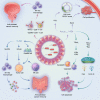Health and Disease: Akkermansia muciniphila, the Shining Star of the Gut Flora
- PMID: 37040299
- PMCID: PMC10079265
- DOI: 10.34133/research.0107
Health and Disease: Akkermansia muciniphila, the Shining Star of the Gut Flora
Abstract
Akkermansia muciniphila (A. muciniphila) has drawn much attention as an important gut microbe strain in recent years. A. muciniphila can influence the occurrence and development of diseases of the endocrine, nervous, digestive, musculoskeletal, and respiratory systems and other diseases. It can also improve immunotherapy for some cancers. A. muciniphila is expected to become a new probiotic in addition to Lactobacillus and Bifidobacterium. An increase in A. muciniphila abundance through direct or indirect A. muciniphila supplementation may inhibit or even reverse disease progression. However, some contrary findings are found in type 2 diabetes mellitus and neurodegenerative diseases, where increased A. muciniphila abundance may aggravate the diseases. To enable a more comprehensive understanding of the role of A. muciniphila in diseases, we summarize the relevant information on A. muciniphila in different systemic diseases and introduce regulators of A. muciniphila abundance to promote the clinical transformation of A. muciniphila research.
Figures




Similar articles
-
Akkermansia muciniphila as a Next-Generation Probiotic in Modulating Human Metabolic Homeostasis and Disease Progression: A Role Mediated by Gut-Liver-Brain Axes?Int J Mol Sci. 2023 Feb 15;24(4):3900. doi: 10.3390/ijms24043900. Int J Mol Sci. 2023. PMID: 36835309 Free PMC article. Review.
-
A next-generation beneficial microbe: Akkermansia muciniphila.J Clin Biochem Nutr. 2018 Jul;63(1):33-35. doi: 10.3164/jcbn.18-57. Epub 2018 Jun 20. J Clin Biochem Nutr. 2018. PMID: 30087541 Free PMC article. Review.
-
Strategies to promote abundance of Akkermansia muciniphila, an emerging probiotics in the gut, evidence from dietary intervention studies.J Funct Foods. 2017 Jun;33:194-201. doi: 10.1016/j.jff.2017.03.045. Epub 2017 Mar 29. J Funct Foods. 2017. PMID: 30416539 Free PMC article.
-
[Research Progress on the Role of Akkermansia Muciniphila in Prevention and Treatment of Diabetes Mellitus].Zhongguo Yi Xue Ke Xue Yuan Xue Bao. 2023 Feb;45(1):108-116. doi: 10.3881/j.issn.1000.503X.14497. Zhongguo Yi Xue Ke Xue Yuan Xue Bao. 2023. PMID: 36861163 Chinese.
-
Akkermansia muciniphila: a potential candidate for ameliorating metabolic diseases.Front Immunol. 2024 Mar 20;15:1370658. doi: 10.3389/fimmu.2024.1370658. eCollection 2024. Front Immunol. 2024. PMID: 38571945 Free PMC article. Review.
Cited by
-
Gut Microbiota: Potential Therapeutic Target for Sickle Cell Disease Pain and Complications.Anemia. 2024 Mar 19;2024:5431000. doi: 10.1155/2024/5431000. eCollection 2024. Anemia. 2024. PMID: 38533265 Free PMC article. Review.
-
Gut microbial community and fecal metabolomic signatures in different types of osteoporosis animal models.Aging (Albany NY). 2024 Jan 26;16(2):1192-1217. doi: 10.18632/aging.205396. Epub 2024 Jan 26. Aging (Albany NY). 2024. PMID: 38284894 Free PMC article.
-
The Role of Akkermansia muciniphila on Improving Gut and Metabolic Health Modulation: A Meta-Analysis of Preclinical Mouse Model Studies.Microorganisms. 2024 Aug 9;12(8):1627. doi: 10.3390/microorganisms12081627. Microorganisms. 2024. PMID: 39203469 Free PMC article. Review.
-
Akkermansia muciniphila: A promising probiotic against inflammation and metabolic disorders.Virulence. 2024 Dec;15(1):2375555. doi: 10.1080/21505594.2024.2375555. Epub 2024 Aug 27. Virulence. 2024. PMID: 39192579 Free PMC article. Review.
-
Meta-analysis of the human gut microbiome uncovers shared and distinct microbial signatures between diseases.bioRxiv [Preprint]. 2024 Feb 29:2024.02.27.582333. doi: 10.1101/2024.02.27.582333. bioRxiv. 2024. Update in: mSystems. 2024 Aug 20;9(8):e0029524. doi: 10.1128/msystems.00295-24. PMID: 38464323 Free PMC article. Updated. Preprint.
References
-
- Cryan JF, O'Riordan KJ, Cowan CSM, Sandhu KV, Bastiaanssen TFS, Boehme M, Codagnone MG, Cussotto S, Fulling C, Golubeva AV, et al. . The microbiota-gut-brain axis. Physiol Rev. 2019;99(4):1877–2013. - PubMed
LinkOut - more resources
Full Text Sources
Molecular Biology Databases

